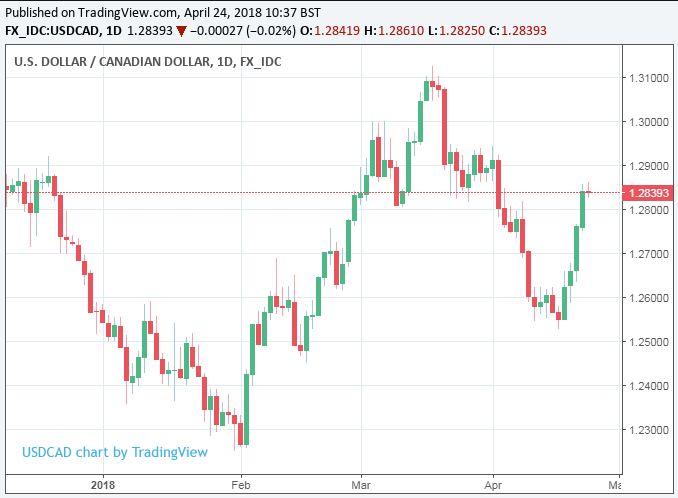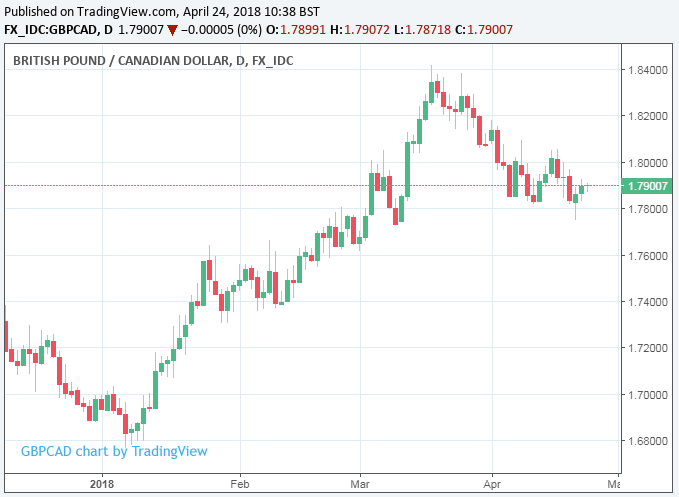The Canadian Dollar Rises with Risk Currencies after Poloz Delivers Upbeat Assessment of the Economy
- Written by: James Skinner
-
- BoC governor delivers upbeat assessment of Canadian economy.
- Canadian interest rate outlook is still favourable to the Loonie.
- USD/CAD seen higher but Loonie to rise against others in coming months.

© COSPV, Adobe Stock
The Canadian Dollar rose Tuesday as markets bid risk currencies higher while also responding to an upbeat assessment of the economy by Bank of Canada governor Stephen Poloz.
Poloz told a panel of Canadian lawmakers overnight that, despite a longer and deeper than expected slowdown in the first quarter, the economy remains in rude health and growth is expected to rebound during the second quarter.
Policymakers have seen clear progress on all four major concerns previously held by the bank, including inflation, wages, capacity in the economy and household sensitivity to higher interest rates, according to Poloz.
Canadian inflation has risen above the 2% target of late and, although a fallback is likely in the months ahead, Poloz and other BoC policymakers are confident that price pressures will remain at or around 2% for the foreseeable future.
This is while the all-important wage growth metrics followed by central bankers the world over have picked up notably to near 3% since the beginning of last year, which supports the BoC's inflation expectations.
In addition, Poloz told lawmakers that household borrowing is beginning to slow, which suggests consumers are beginning to reign in their appetite for credit in the wake of the BoC's three interest rate rises in the last 10 months.
Moreover, but perhaps less positively for the Canadian Dollar, the economy is now seen as having more capacity to grow without stoking inflation pressures over the coming quarters. This means, if anything, the BoC can justify waiting a bit longer before it raises interest rates again.
"This progress reinforces our view that higher interest rates will be warranted over time, although some degree of monetary policy accommodation will likely still be needed to keep inflation on target. The Bank will continue to monitor the economy’s sensitivity to interest rate movements and the evolution of economic capacity. In this context, Governing Council will remain cautious with respect to future policy adjustments, guided by incoming data," Poloz told lawmakers.
Canada's interest rate is currently set at 1.25%. Until recently, markets had been betting the BoC would raise it again in April although the bank opted not to do this at its latest policy meeting last week.
Many are now looking to the July meeting for the next rate hike, interest rate derivatives market pricing implying a 76% probability that the cash rate will be raised to 1.5% by July 11.
"The BoC is among the central banks that are doing their best to suppress its currency through a soft stance on policy. However, with WTI crude entrenched above $60 and Western Canada Select above $50, a bit of CAD appreciation is likely," says Stephen Gallo, head of G10 FX strategy at BMO Capital Markets.
Monday's testimony marked the first of two appearances from Poloz this week, with the second due Wednesday, both of which will see him grilled on the Bank of Canada's recent monetary policy decisions and its outlook for the economy.
It also came closely on the heels of the April interest rate announcement that saw Poloz hold Canada's interest rate unchanged at 1.25% and tell markets a recent rise in inflation was largely the result of "transitory" factors, which also suggested the bank is in no rush to raise its interest rate again any time soon.
The Canadian Dollar tumbled on the outcome of the event.
"Governor Poloz's Parliamentary testimony (Monday and Wednesday) is the most notable risk event but is likely to repeat recent, albeit dovish, messaging," says Fred Demers, chief Canada macro strategist at TD Securities, a Canada-headquartered investment bank.
Demers' view is uncontroversial given the BoC's latest interest rate statement was delivered just last week and, judging by the relatively tame content of and benign reaction to Monday's speech, it would appear there is likely to be only a limited reaction to Wednesday's testimony.

Above: USD/CAD rate shown at daily intervals.
The USD/CAD rate was quoted 0.06% lower at 1.2835 Tuesday while the Pound-to-Canadian-Dollar rate was 0.03% lower at 1.7896. Canada's unit traded higher against most of other developed world rivals during the morning session barring the Swedish Krona and Australian Dollar.

Above: Pound-to-Canadian-Dollar rate shown at daily intervals.
"A mix of data and the BoC butchered the loonie last week, suffering one of biggest weekly pullbacks in a month. USDCAD is now back to our gauge of high-frequency fair value (HFFV) following a few weeks of CAD overvaluation. We prefer to remain nimble on our near-term USDCAD view given the counterbalancing forces currently in play," says Mark McCormick, head of North American FX strategy at TD Securities.
McCormick and the TD foreign exchange team have been bullish in their commentary on the USD/CAD rate during recent weeks, suggesting it could rise back to the 1.30 level, but are now flagging oil prices and the NAFTA negotiations as risks to this view.
Oil prices have enjoyed a strong run in recent months after rising by around 6% since the start of the year but from here onward, they could move sharply in either direction.
First and foremost, President Donald Trump has pledged to make announce by May 12 whether the US will remain party to the so called "Iranian nuclear deal" that has enabled Iranian oil producers to begin selling their produce on global markets once again. Any resumption of US sanctions on Iranial oil could hamper global supply and send oil prices marching North.
"A temporary supply shock emanating from any scuppering of the US/Iran deal could be worth a $5-10bbl move in WTI. That is worth a 1% move in the [USD/CAD] pair given current betas," says McCormick, suggesting the Canadian Dollar could benefit from any disruption to the deal, which would push USD/CAD lower.
However, on the opposite side of the same coin, President Trump has recently taken aim at the Organization of Petroleum Exporting Countries when expressing concern about artificially high prices. He hinted that this price manipulation would have to end but did not say what the US plans to do about it.
Looks like OPEC is at it again. With record amounts of Oil all over the place, including the fully loaded ships at sea, Oil prices are artificially Very High! No good and will not be accepted!
— Donald J. Trump (@realDonaldTrump) April 20, 2018
Any action from the US that leads to lower prices would almost certainly be bad for the Canadian Dollar given that crude oil is Canada's largest export.
"The NAFTA headlines continue to get incrementally more positive, suggesting the room for an in-principal to get inked over the coming weeks. While we think most of the good news is priced in, there is still scope for a knee-jerk positive that could interrupt a straight shot to 1.30," McCormick adds.
Negotiators from Canada, Mexico and the US have been attempting to renegotiate the North American Free Trade Agreement for almost a year now and, according to many of the latest reports on the status of talks, are beginning to make some progress.
Mexico, whose laws on immigration are very tough, must stop people from going through Mexico and into the U.S. We may make this a condition of the new NAFTA Agreement. Our Country cannot accept what is happening! Also, we must get Wall funding fast.
— Donald J. Trump (@realDonaldTrump) April 23, 2018
President Trump's dislike of the NAFTA agreement is well known after he described it as "the worst deal in history" when on the campaign trail. It was all but torn to pieces until late March when the White House was reported to have offered a key concession and begun pushing for a token agreement to be concluded some time this month.
This is important given analysts have previously estimated that a NAFTA withdrawal by the US could hit the Canadian economy hard and see the Loonie fall by as much as 20%. Conversely, the Loonie could also rise strongly if and when a deal is clinched. Some, including TD's McCormick, say there is scope for a deal to be reached before the month is out.
"We flag these as risks factors, and our base case looks for choppy grind higher in USDCAD. This reflects the weakening macro story alongside a lower real rate story," McCormick writes, in a note Monday.
McCormick and the TD Securities team are flagging the possibility for divergence in Canadian Dollar exchange rates over the coming months. They say the USD/CAD rate likely to rise due to higher US interest rates and an uncertain outlook for Canadian monetary policy but that the Loonie can still prevail over weaker developed world peers like the New Zealand Dollar during the interim.
"We still hold less sympathy for NZD, which keeps us short NZDCAD for a touch longer," McCormick writes. "The 200 day moving average sits at 0.9067, and we continue to eye a break of that level as well, with our trade recommendation targeting a move to 0.90."
Advertisement
Get up to 5% more foreign exchange by using a specialist provider to get closer to the real market rate and avoid the gaping spreads charged by your bank when providing currency. Learn more here.










